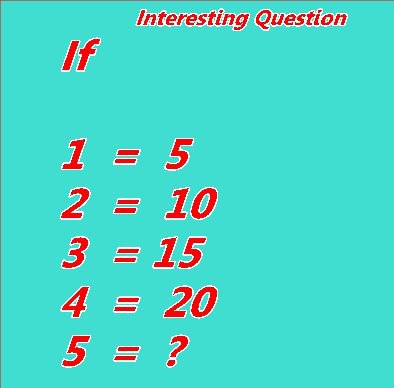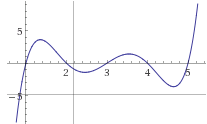Interesting question, if 1=5, 2=10, 3=15, 4=20… what is 5=? (Trolling with maths)
November 13th, 2012
This image has been going around Facebook lately. What is the answer?
You might be rushing to say obviously 25! You might solve the equation and get this answer. But if you’re a bit of a smart-ass you might be thinking, hey wait a minute, those are equals signs! The answer is obviously 1! It says so on the first line. If 1=5, then surely 5=1. If you’re even more of a smart-ass you might point out that the 1-5 on the left side could be symbols, (much like x or y) and that the value of the symbol 5 could be anything.
However, let’s pretend that the correct interpretation is that you put the left side into some function f(x), such that you get the value on the right side.
f(1) = 5
f(2) = 10
f(3) = 15
f(4) = 20
f(5) = ?
The obvious candidate would be f(x) = 5x, in other words to multiply the number on the left side by 5, which would give f(5)=25.
That’s boring. Can we construct a function such that the first four lines still hold true, while f(5) takes on any arbitrary value? The answer is yes. You might remember from math class that you can solve a polynomial equation by moving everything to one side so you have (some polynomial) = 0 and then factoring the polynomial.
x3 - 6x2 + 5x = -12
could also be factored and written as
(3-x)(4-x)(1+x) = 0
You can confirm this by expanding the latter expression and realize that the fully expanded form matches the former expression. The latter form has an advantage when solving the equation because = 0 puts a constraint on the left side: anything multiplied by zero equals zero. For this reason, we know that for example when 3-x = 0, the whole expression on the left side equals zero. We can see that if x = 3, the whole expression becomes
(3-3)(4-3)(1+3) = 0*1*4 = 0
and we can conclude that since we have equality, x=3 is one of the roots for the equation.
Enough with the repetition of high school maths. How does this help us create a function that can give us an arbitrary value for f(5)? Well, let’s begin by crafting a function that returns 0 for all the values involved:
f(x) = (x-1)(x-2)(x-3)(x-4)(x-5)
Like before, if x = 3, then x-3 = 0 and the whole expression is zeroed out. It will still have all sorts of values for values of x other than our list of integers, 1 to 5. f(2.5) = 1.40625 for example, but we don’t care about that, for our purposes, do we?
We now have:
f(1) = 0
f(2) = 0
f(3) = 0
f(4) = 0
f(5) = 0
Here’s the graph for good measure, even though we don’t care about what the function does for other values.

Pretty neat. We can now remove one term from this multiplication, say x-1 so you get f(x) = (x-2)(x-3)(x-4)(x-5) 2 to 5 will still be “zeroed” like before, whereas 1 will now have a non-zero value.
f(1) = 24
f(2) = 0
f(3) = 0
f(4) = 0
f(5) = 0
A similar expression could be created by removing the (x-2) part from the original expression: f(x) = (x-1)(x-3)(x-4)(x-5)
f(1) = 0
f(2) = -6
f(3) = 0
f(4) = 0
f(5) = 0
And so on with each term of the multiplication…
The important thing to realize, is that you can add these expressions together and use each expression to single out one of the integers in the range, and modify its value. You do this by multiplying one of the sub-expressions by any suitable value. Since any of the sub-expressions will only have a non-zero value when x equals a particular value in the list.
So let’s try out our new super powers.
f(x) = (2-x)(3-x)(4-x)(5-x) +
(1-x)(3-x)(4-x)(5-x) +
(1-x)(2-x)(4-x)(5-x) +
(1-x)(2-x)(3-x)(5-x) +
(1-x)(2-x)(3-x)(4-x)
f(1) = 24
f(2) = -6
f(3) = 4
f(4) = -6
f(5) = 24
Now you can normalize each sub-expression by dividing it with output of that expression for that value x.
f(x) = (2-x)(3-x)(4-x)(5-x)/24 +
(1-x)(3-x)(4-x)(5-x)/-6 +
(1-x)(2-x)(4-x)(5-x)/4 +
(1-x)(2-x)(3-x)(5-x)/-6 +
(1-x)(2-x)(3-x)(4-x)/24
f(1) = 1
f(2) = 1
f(3) = 1
f(4) = 1
f(5) = 1
Now you can multiply each sub-expression by the value you want the function to return for the corresponding value of x.
f(x) = 5 * (2-x)(3-x)(4-x)(5-x)/24 +
10 * (1-x)(3-x)(4-x)(5-x)/-6 +
15 * (1-x)(2-x)(4-x)(5-x)/4 +
20 * (1-x)(2-x)(3-x)(5-x)/-6 +
42 * (1-x)(2-x)(3-x)(4-x)/24
f(1) = 5
f(2) = 10
f(3) = 15
f(4) = 20
f(5) = 42
Now you can claim that the number series in the image actually represents this particular function you just created and that the correct answer for “5 =” is whatever you want it to be.
Boredom -> trolling with maths in ways no one gives a shit about.
![You suck at protoshop. No, you [i]really[/i] oo.](http://blog.gg8.se/images/you-suck-at-photoshop-you-really-do-your-awful.png)



November 13th, 2012 at 8:45 am
I want it to be 45.
December 20th, 2012 at 3:17 pm
What type of DMT is in your PCP?
December 20th, 2012 at 3:25 pm
I prefer LSD-laced DMT in my PCP.
January 31st, 2013 at 5:14 am
Cool! Nice work!
March 6th, 2013 at 4:35 pm
if 1=5 so 5=1..the end
March 20th, 2013 at 7:20 pm
W T K ?
Seriously folks…get a life…go out…have a beer or two…meet some friends…go and see a play/film/concert/ballet/opera…have a gorgeous meal…buy some new item of clothing…read a book…write a book…visit an art gallery and sit a gaze at a painting…go and experience the wonder of the natural world…climb a mountain…swim with dolphins…the possibilities are endless!
March 25th, 2013 at 8:28 pm
the answer is 25
June 5th, 2013 at 10:26 am
This is a troll question that is plaguing Facebook in various forms. All of you are assuming that there is a pattern, and basing your answer on said pattern. The reality is that the LANGUAGE of math dictates that there is only one answer. What is on the left side of an equation must equal what is on the right to make said equation true. You could say that 10/2=5, or That the square root of 25 = 5. But what you’re looking at in these questions is a series of false statements attempting to troll you into finding a pattern. At the end of the day, the only equivalent to the number 5 is, well, 5.
June 5th, 2013 at 10:41 am
Greg, you didn’t even read my post. I’m way ahead of that.
December 29th, 2013 at 7:51 pm
f(5)= -inf : +inf
February 6th, 2014 at 9:36 pm
1=5
2=10
3=14
4=20
5=?
February 6th, 2014 at 9:38 pm
Can someone solve this????????
August 1st, 2014 at 8:27 am
If 1 = 5, then 5 = 1.
August 15th, 2014 at 4:55 pm
W.t.f
If 1=5 5=1
Why put 4 logically answer?
1=5 (1×5=5)
2=10 (2×5=10)
3=15 (3×5=15)
4=20 (4×5=20)
Finally u said
5=1?
I can also make a question
If
1+1=2
2+2=4
3+3=6
4+4=8
5+5=? The question is 5+5=2×5, I answer what I want to answer! U know why? Coz I made the question!
January 8th, 2015 at 1:41 pm
Its answer is 25
February 9th, 2015 at 11:40 pm
Hah gayyyyyyyyyyyyyyyyyyyyyyyyyyyy 9+10=21
December 25th, 2015 at 2:36 pm
5=1